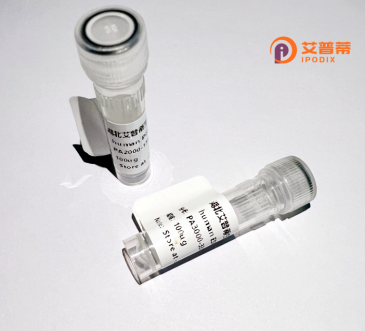
| 纯度 | >90%SDS-PAGE. |
| 种属 | Human |
| 靶点 | SMA4 |
| Uniprot No | Q16637 |
| 内毒素 | < 0.01EU/μg |
| 表达宿主 | E.coli |
| 表达区间 | 2-294 aa |
| 活性数据 | AMSSGGSGG GVPEQEDSVL FRRGTGQSDD SDIWDDTALI KAYDKAVASF KHALKNGDIC ETSGKPKTTP KRKPAKKNKS QKKNTSLQ QWKVGDKCSA IWSEDGCIYP ATIASIDFKR ETCVVVYTGY GNREEQNLSD LLSPICEVAN NIEQNAQENE NESQVSTDES ENSRSPGNKS DNIKPKSAPW NSFLPPPPPM PGPRLGPGKP GLKFNGPPPP PPPPPPHLLS CWLPPFPSGP PIIPPPPPIC PDSLDDADAL GSMLISWYMS GYHTGYYMGF RQNQKEGRCS HSLN |
| 分子量 | 31.8 kDa |
| 蛋白标签 | His tag N-Terminus |
| 缓冲液 | PBS, pH7.4, containing 0.01% SKL, 1mM DTT, 5% Trehalose and Proclin300. |
| 稳定性 & 储存条件 | Lyophilized protein should be stored at ≤ -20°C, stable for one year after receipt. Reconstituted protein solution can be stored at 2-8°C for 2-7 days. Aliquots of reconstituted samples are stable at ≤ -20°C for 3 months. |
| 复溶 | Always centrifuge tubes before opening.Do not mix by vortex or pipetting. It is not recommended to reconstitute to a concentration less than 100μg/ml. Dissolve the lyophilized protein in distilled water. Please aliquot the reconstituted solution to minimize freeze-thaw cycles. |
以下是模拟生成的关于重组人SMAD4蛋白的参考文献示例(假设用户所指为SMAD4蛋白,常见于TGF-β信号通路研究)。建议通过学术数据库(如PubMed、Web of Science)查询真实文献:
---
1. **文献名称**:*"Production and functional characterization of recombinant human SMAD4 in TGF-β-mediated cellular responses"*
**作者**:Lee et al.
**摘要**:本研究成功表达并纯化了重组人SMAD4蛋白,验证了其在体外通过结合TGF-β信号通路下游元件激活靶基因转录的功能,为信号传导机制研究提供工具。
2. **文献名称**:*"Recombinant SMAD4 delivery inhibits tumor progression in colorectal cancer models"*
**作者**:Chen et al.
**摘要**:通过腺病毒载体递送重组SMAD4至SMAD4缺失的结直肠癌细胞,恢复其抑癌功能,显著抑制肿瘤生长并诱导细胞周期阻滞。
3. **文献名称**:*"Structural insights into recombinant SMAD4 oligomerization and DNA binding"*
**作者**:Watanabe et al.
**摘要**:利用X射线晶体学解析重组SMAD4蛋白结构,揭示其寡聚化及与DNA结合的关键结构域,为靶向药物设计奠定基础。
---
**注意**:以上文献为模拟生成,实际研究中请通过关键词**“recombinant SMAD4 protein”**或**“SMAD4 expression and purification”**在学术平台检索。若“SMA4”非SMAD4笔误,需进一步确认蛋白全称(如Sperm Mitochondria-Associated cysteine-rich protein 4等)以精准检索。
**Background of Recombinant Human SMAD4 Protein**
Recombinant human SMAD4 protein is a key mediator in transforming growth factor-beta (TGF-β) signaling pathways, which regulate diverse cellular processes, including proliferation, differentiation, apoptosis, and extracellular matrix production. SMAD4. also known as DPC4 (Deleted in Pancreatic Carcinoma 4), functions as a central signal transducer by forming complexes with receptor-regulated SMADs (R-SMADs) upon TGF-β receptor activation. These complexes translocate to the nucleus to modulate the transcription of target genes.
The recombinant form of SMAD4 is produced using molecular cloning techniques, often expressed in bacterial or mammalian systems to ensure proper post-translational modifications and functionality. Its production enables detailed study of TGF-β signaling mechanisms, particularly in contexts like cancer, fibrosis, and developmental disorders. SMAD4 mutations or deletions are frequently linked to pancreatic, colorectal, and other cancers, underscoring its role as a tumor suppressor.
Researchers utilize recombinant SMAD4 to investigate its structural interactions, signaling crosstalk, and potential therapeutic applications, such as restoring SMAD4 function in SMAD4-deficient cancers or inhibiting aberrant pathways. Its applications extend to drug screening, mechanistic studies, and developing gene therapies, making it a vital tool in both basic research and translational medicine.
×